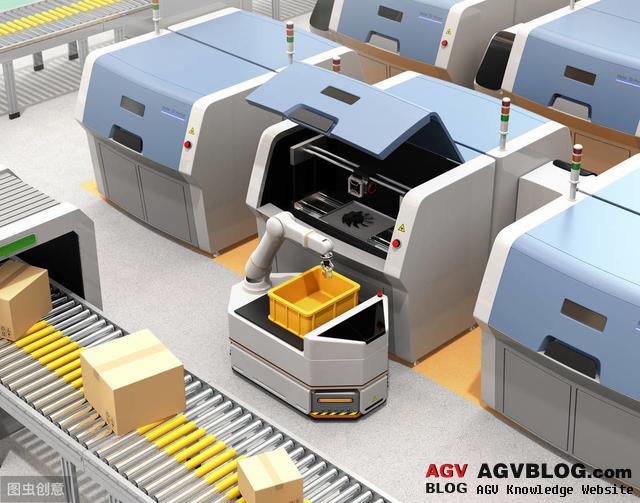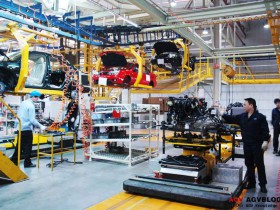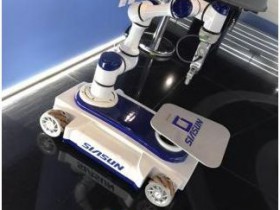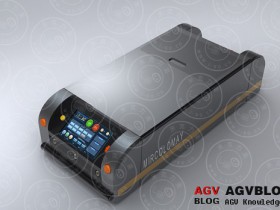
Many people do not have a clear concept of the differences and connections between RGV, AGV, and IGV. What is the difference between RGV, AGV and IGV? Let's start with the concept.
With the rapid rise of smart manufacturing in the world, the forthcoming fourth industrial revolution has also caused the rapid development of the smart manufacturing industry. As one of the core equipment of smart logistics, mobile handling robots have shown explosive growth in recent years. In addition to common AGVs, RGV and IGV are also an indispensable part of the automated logistics system.
01, the meaning of RGV, AGV and IGV
RGV: The full name is Rail Guided Vehicle, that is, "rail-guided vehicle", also known as "rail shuttle car". RGV is commonly used in all kinds of high-density storage three-dimensional warehouses. The trolley channel can be designed to be arbitrarily long as needed, and no other equipment is needed to enter the roadway when handling or moving goods. The speed is fast and the safety is high, which can effectively improve the operating efficiency of the warehouse system .
AGV: The full name is Automated Guided Vehicle, which means "automatic guided transport vehicle". AGV is a transport trolley equipped with electromagnetic, optical or other automatic guidance devices, capable of driving along a prescribed guidance path, and having safety protection and various transfer functions.
IGV: The full name is Intelligent Guided Vehicle, that is, intelligent guided transport vehicle. IGV is a new concept proposed in recent years. Compared with the traditional AGV, the IGV is more flexible, does not need to use any fixed markers to drive, and the route is flexible and can be flexibly scheduled according to actual production needs.
RGV, AGV and IGV are used to realize the automatic handling and reprinting of materials, but in terms of automation and intelligence, RGV
RGV, AGV and IGV are not eliminated because of different levels of automation and intelligence, but each plays an irreplaceable role in different applications.
02. Characteristics and applicable scenarios of RGV
RGV has a wide range of applications in logistics systems and station production lines, such as out / in warehouse stations, various buffer stations, conveyors, elevators and line-side stations, etc., according to the plan and instructions for material transportation, can be significant Reduce transportation costs and improve transportation efficiency.
Because RGV is driven by rail, its application is relatively simple, and it can be classified and identified in two ways. First, it can be divided into two types of assembly type RGV and transportation type RGV according to function, mainly used for material transportation, workshop assembly, etc. The second is that it can be divided into a circular track type and a linear reciprocating type according to the movement mode. The circular track type RGV system has high efficiency and can work with multiple vehicles at the same time. The linear reciprocating type generally has only one RGV. For linear reciprocating movement, the efficiency is relative to the circular RGV The system is relatively low.
In structure, RGV is mainly composed of frame, driving wheel, follower wheel, front and rear bumpers, chain conveyor, communication system, electrical system and cover plates. Due to the simple structure of RGV, its strong anti-interference ability to the external environment, the requirements for the operator are also relatively wide, the operation stability is strong, the failure occurs relatively less, the overall maintenance cost is relatively low, and the reliability is high.
It is also because RGV can only walk on the track, and it is difficult and costly to reconstruct the RGV route after it is determined, so the adaptability to the use place and its own scalability are relatively poor.
03. Features and applicable scenarios of AGV
The AGV (IGV) system is widely used in three-dimensional storage systems and flexible production lines. It is also the best choice for many manufacturing enterprises to improve production efficiency and reduce production costs.
Because AGV is a trackless driving, it has a wide range of applications, a variety of structural forms and control methods, so there are many types of AGV.
The main advantages of AGV
①High working efficiency
The AGV car can realize the automatic charging function. Under the premise of safety redundancy, it can achieve 24 hours of continuous operation, which greatly improves the efficiency of product materials and other handling.
②Save management effort
AGV realizes all-digital management, which can effectively avoid human factors and improve management level.
③Good flexibility and system expandability
In addition to the traditional position, speed, acceleration, etc., the development of smart sensors for smart AGV vehicles also uses machine vision, force feedback, and other multi-smart sensor fusion technologies for decision control. The AGV equipment system has mature applications.
④High reliability
Compared with the inefficiency of manual handling, the unknown path, speed, and safety of forklifts and trailers, AGV's driving path and speed can be controlled, and positioning and parking are accurate, thereby greatly improving the efficiency of material handling. At the same time, AGV central management system, The AGV car can be monitored throughout the process, and the reliability is greatly improved.
⑤High safety
AGV has relatively complete safety protection capabilities, intelligent traffic route management, safety and collision avoidance, multi-level warnings, emergency braking, failure reports, etc., which can play a unique role in many places not suitable for human work.
Compared with RGV, AGV has a wider range of application scenarios. AGV plays an important role in different aspects of manufacturing such as machining, warehousing, and assembly. It has even become one of the most iconic configurations of modern smart factories.
⑥AGV selection manual
As an indispensable tool for intelligent logistics warehousing, AGV car has been widely used in the manufacturing industry, and the market demand has shown a blowout growth. However, there are still many problems in the AGV market, and manufacturers often lack correct guidance when selecting products. e-works launches AGV product selection manuals to help manufacturing companies choose models.
The composition of AGV
AGV usually consists of the following components:
Body: It is composed of the frame and the corresponding mechanical devices. It is the basic part of the AGV and the installation basis of other assembly components.
Power storage and charging device: It is composed of a charging station and an automatic charging machine. AGV can complete automatic online charging and is centrally managed by a central control system to achieve 24-hour continuous production.
Driving device: It is composed of wheels, reducers, brakes, driving motors and speed controllers. It is a device that controls the normal operation of AGV. The running command is issued by computer or manual control, and the adjustment of running speed, direction and braking is controlled by computer. For safety, the braking device is realized by mechanical braking method when power is cut off.
Guiding device: accept the direction information of the guiding system to ensure that the AGV car walks along the correct path.
Communication device: to realize the exchange of information between AGV, console and monitoring equipment.
Safety and auxiliary devices: In order to avoid the AGV from colliding when the system fails or when someone passes the AGV working route, the AGV generally has obstacle detection and collision avoidance, warning sounds, warning, emergency stop and other devices.
Transfer device: a device that makes direct contact with the goods being transported and realizes the transfer of the goods. In different tasks and site environments, different transfer systems can be selected, and the commonly used ones are roller type, forklift type, and manipulator type.
Central control system: composed of computer, task acquisition system, alarm system and related software. It is mainly divided into ground (upper) control system and vehicle-mounted (lower) control system. Among them, the ground control system refers to the fixed equipment of the AGV system, which is mainly responsible for tasks such as task allocation, vehicle scheduling, route (line) management, traffic management, and automatic charging. After the vehicle-mounted control system receives the command from the higher-level system, it is responsible for the AGV's navigation calculation, guidance implementation, vehicle walking, loading and unloading operations and other functions.
The value of AGV
AGV is characterized by wheeled movement. Compared with walking, crawling or other non-wheeled mobile robots, it has the advantages of fast action, high work efficiency, simple structure, strong controllability, and good safety. Compared with other equipment commonly used in material transportation, AGV's active area does not need to lay rails, support frames and other fixed devices, and is not limited by the site, road and space. Therefore, it can fully reflect its automation and flexibility to achieve efficient, economical, and flexible unmanned production. Its advantages are mainly manifested in:
high working efficiency;
high degree of automation;
Avoid manual operation and low error rate;
Charging automation;
Convenient, reduce the floor space;
Relatively low cost;
Beautiful, improve viewing, improve corporate image
AGV key technologies and development trends
Guidance technology
As a branch of wheeled mobile robots, AGV's main feature is automatic guidance. With the development of various technologies, AGV's guidance technology has also been continuously improved. At present, the commonly used guidance methods are: electromagnetic guidance, magnetic tape guidance, ribbon guidance, laser guidance, inertial guidance, visual guidance, GPS guidance, coordinate guidance, etc.
Drive method
At present, the common driving methods of AGV can be summarized into four types: single-wheel drive, differential drive, two-wheel drive, and all-round drive. According to the number of wheels, there are mainly three-wheel models and four-wheel models. When selecting the model, choose according to the actual road conditions and functional requirements of the work site.
powered by
The traditional AGV power supply generally uses batteries as energy storage carriers. Currently, the types of batteries that can be used by AGV are: lead acid / pure lead, nickel-metal hydride, nickel-cadmium, and lithium-ion batteries. In recent years, with the maturity of battery technology, the application of super capacitors in AGV has gradually been promoted, and with the development of contactless energy transmission technology, related products have replaced the traditional power supply mode of AGV in some fields.
System control
It is mainly divided into ground (upper) control system and vehicle-mounted (lower) control system. The higher-level control system effectively controls multiple AGVs, optimizes the ordering of tasks, dynamically plans the distribution of AGVs and driving paths, and realizes intelligent traffic management. After receiving the instructions from the higher-level system, the lower-level control system is responsible for functions such as navigation calculation, guidance implementation, vehicle walking, and loading and unloading operations.
AGV Market Overview
AGV market development status
The market size of AGV continues to grow. In addition to the traditional "big households" used by AGV, such as automobiles and tobacco, industries such as electronics and home appliances will also lead AGV sales. In addition, construction machinery, medicine, power, chemical industry, papermaking, national defense, new materials and other industries have been promoted and applied. In addition to warehousing and handling, AGV presents a wider range of applications in manufacturing companies. Foreign brands still have significant advantages, and domestic manufacturers are constantly catching up.
Listed below are some manufacturers, in no particular order:
①Shenyang Xinsong Robot Automation Co., Ltd.
Xinsong Robot Automation Co., Ltd. belongs to the Chinese Academy of Sciences. It is a high-tech listed company with robot technology as its core and dedicated to fully intelligent products and services. It is one of the most comprehensive robot product lines in the world and the largest robot industrialization in China. base. With an R & D and innovation team of more than 2,000 people, a complete industry value chain with independent core technology, core components, leading products and industry system solutions is formed.
②Guangzhou Jingyuan Electromechanical Equipment Co., Ltd.
Guangzhou Jingyuan Electromechanical Equipment Co., Ltd. is a national high-tech enterprise focusing on mobile robots, automated logistics systems, and intelligent equipment systems. It is the earliest domestic launch of a tape navigation robot enterprise with independent intellectual property rights. It has set up branches in many cities in China, and currently has nearly 200 employees.
③Yunnan Kunchuan Intelligent Equipment Co., Ltd.
Yunnan Kunchuan Intelligent Equipment Co., Ltd. is a subsidiary of China Shipbuilding Industry Corporation. It is fully responsible for the research and development, design, production, operation and after-sales service of Kunming AGV products (systems) and related intelligent equipment. As of July 2016, Kunming Ship Intelligence Co., Ltd. has designed 139 AGV systems for users, and has produced more than 1,240 various types of AGV stand-alone machines. The projects are all over the country, and there are application examples of Kunchuan AGV in tobacco, automobiles, engines, food, medicine, chemicals, paper / printing, national defense, education, etc.
④Jike Development Technology Co., Ltd.
Jike is a central enterprise specializing in providing intelligent high-end manufacturing equipment and system integration and environmental protection equipment and engineering. The main technologies and products are robots and related equipment, automation equipment, product customization and services, solid waste disposal equipment and engineering, water Processing equipment and engineering, etc., the main technologies and products serve the core areas of the national economy such as environmental protection, automobiles, intelligent manufacturing, logistics, construction machinery, metallurgy, printing and national defense.
⑤Guangdong Jiateng Robot Automation Co., Ltd.
Guangdong Jiateng Robot Automation Co., Ltd. was established in 2002. It is one of the top ten brands of industrial robots in China and a member of the German Logistics Alliance BVL. Jiateng has been focusing on independent research and development of unmanned handling technology since 2005. It has more than 60 patents or copyrights and is committed to providing customers with complete solutions for intelligent logistics and intelligent manufacturing. More than 50 Fortune 500 companies have chosen Jiateng's intelligent logistics or intelligent manufacturing solutions, more than 5,000 Jiateng AGVs are used in enterprises around the world.
⑥Guangzhou Yuanneng Logistics Automation Equipment Technology Co., Ltd.
Guangzhou Yuanneng Logistics Automation Equipment Technology Co., Ltd. is headquartered in Guangzhou, with subsidiaries in Shanghai, Jiangxi Jiujiang has established a large manufacturing base, with two technology R & D centers in Guangzhou and Shanghai, and Dalian, Wuhan, Chongqing, Zhengzhou There are offices abroad. The main business of Yuanneng Company is divided into three major sections: intelligent equipment, intelligent logistics and intelligent parking garage. The company has 15 independent software copyrights, 10 utility model patents, 5 invention patents, 8 appearance patents, and 4 trademark registrations. It is a national high-tech enterprise.
⑦Hunan Chizhong Robot Co., Ltd.
Founded in 2012, Hunan Chizhong Robot Co., Ltd., formerly known as Changsha Chizhong Machinery Technology Co., Ltd., is mainly engaged in the R & D and manufacturing of high-tech equipment such as industrial robots and automation equipment. Years of innovation and development have made Chizhong Robot gradually grow into a technologically leading innovative enterprise. Its leading products cover 3 major categories, 11 product series, and more than 40 varieties. AGV products rank among the top ten in China.
⑧Shenzhen Jiashun Intelligent Robot Co., Ltd.
Founded in 2007, Shenzhen Jiashun Intelligent Robot Co., Ltd., formerly known as Shenzhen Jiashun Weiye Technology Co., Ltd., is a national high-tech enterprise specializing in the research, design, production and sales of AGV and automation solutions The development of more than 100% growth rate in 4 years has grown into the most innovative and R & D capable industry leader in China, and successfully landed on the New Third Board in December 2015.
There are many, so I will not list them one by one ...
04. Characteristics and applicable scenarios of IGV
As a result of the continuous innovation and development of AGV technology, IGV has achieved further improvements in accuracy, safety, flexibility, and environmental adaptability.
In terms of flexible guidance, traditional AGVs still need to use two-dimensional codes, reflectors and other marks, while IGV uses a new navigation method, relying on real-time scene maps, no other fixed markers, and simple and flexible path changes ...
IGV is suitable for occasions with higher requirements for flexibility. On the basis of satisfying conventional handling functions, it can also be selectively equipped with different functional modules according to the customer's process flow to meet the purpose of multi-use for one vehicle.
A specific case. AGILOX trolley is a kind of unmanned truck for handling materials. It is equipped with a double-scissor lifting device that can lift cargo or cargo handling equipment (such as pallets) from the ground to a height of 1000 mm. In the basic version, the AGILOX trolley can transport European-style pallets with a maximum weight of 750/1000 kg according to the required scissors height.
The AGILOX car uses group intelligent control, without the host computer, through the WLAN system, the task is sent to the AGILOX car, and intelligently distributed in the fleet.
The AGILOX car's navigation system does not require fixed, installed infrastructure, such as rails or magnetic points, but uses its environmental profile to navigate. The energy is stored by the LiFePo4 battery, and the trolley is charged through the charging contacts when carrying the goods, thus achieving 7 days / 24 hours of operation.




